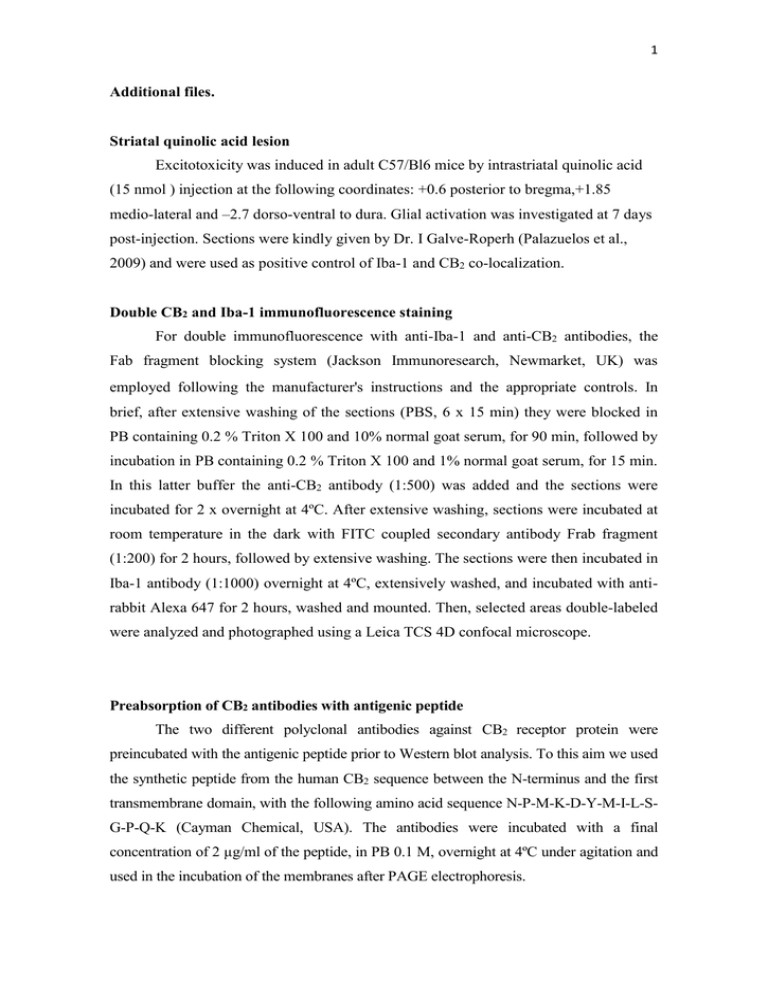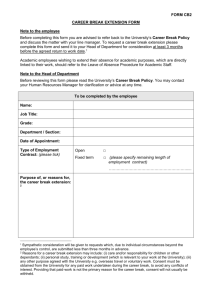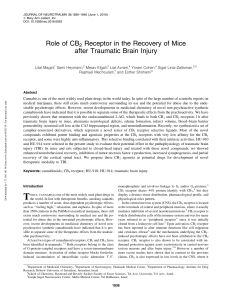1742-2094-9-8-S2.DOC
advertisement

1 Additional files. Striatal quinolic acid lesion Excitotoxicity was induced in adult C57/Bl6 mice by intrastriatal quinolic acid (15 nmol ) injection at the following coordinates: +0.6 posterior to bregma,+1.85 medio-lateral and –2.7 dorso-ventral to dura. Glial activation was investigated at 7 days post-injection. Sections were kindly given by Dr. I Galve-Roperh (Palazuelos et al., 2009) and were used as positive control of Iba-1 and CB2 co-localization. Double CB2 and Iba-1 immunofluorescence staining For double immunofluorescence with anti-Iba-1 and anti-CB2 antibodies, the Fab fragment blocking system (Jackson Immunoresearch, Newmarket, UK) was employed following the manufacturer's instructions and the appropriate controls. In brief, after extensive washing of the sections (PBS, 6 x 15 min) they were blocked in PB containing 0.2 % Triton X 100 and 10% normal goat serum, for 90 min, followed by incubation in PB containing 0.2 % Triton X 100 and 1% normal goat serum, for 15 min. In this latter buffer the anti-CB2 antibody (1:500) was added and the sections were incubated for 2 x overnight at 4ºC. After extensive washing, sections were incubated at room temperature in the dark with FITC coupled secondary antibody Frab fragment (1:200) for 2 hours, followed by extensive washing. The sections were then incubated in Iba-1 antibody (1:1000) overnight at 4ºC, extensively washed, and incubated with antirabbit Alexa 647 for 2 hours, washed and mounted. Then, selected areas double-labeled were analyzed and photographed using a Leica TCS 4D confocal microscope. Preabsorption of CB2 antibodies with antigenic peptide The two different polyclonal antibodies against CB2 receptor protein were preincubated with the antigenic peptide prior to Western blot analysis. To this aim we used the synthetic peptide from the human CB2 sequence between the N-terminus and the first transmembrane domain, with the following amino acid sequence N-P-M-K-D-Y-M-I-L-SG-P-Q-K (Cayman Chemical, USA). The antibodies were incubated with a final concentration of 2 µg/ml of the peptide, in PB 0.1 M, overnight at 4ºC under agitation and used in the incubation of the membranes after PAGE electrophoresis. 2 Table 1 Antibodies used in the study Marker Host Dilution Source CB1 rabbit 1: 600 K.Mackie CB2 rabbit 1: 10,000 (WB) Affinity Bioreagents (PAI-746) CB2 rabbit 1: 500 (IHC) Affinity Bioreagents (PAI-744) COX-2 rabbit 1: 100 (WB) Abcam GFAP mouse 1:1,500 (IHC) Sigma GFAP rabbit 1: 10,000 (WB) Dako p-GSK3-α (Ser21) rabbit 1: 1,000 (WB) Cell Signalling GSK3-α rabbit 1: 2,000 (WB) Cell Signalling p-GSK3-β (Ser9) rabbit 1: 5,000 (WB) Cell Signalling GSK3-β mouse 1: 1,500 (WB) BD Transduction Labs. Iba-1 rabbit 1: 1,000 (IHC) Wako Antibodies used in either inmmunohistochemistry (IHC) or Western blotting (WB) are shown, along the host species, dilution and source. Legend to additional file 1. Co-localization of CB2 and Iba-1 inmmunostaining in quinolinic acid injected striatum. Iba-1 (red) positive microglia in striatum also express CB2 (green) receptor protein ipsilateral to the toxin injection (white arrows B1), but was absent in the contralateral (unlesioned) striatum (A1). Tg APP microglial cells are devoid of CB2 immunostaining (C1). A3, B3 and C3 depicts Iba-1 staining, A2, B2 and C2 CB2 staining and A1, B1 and C1 merged images obtained by laser confocal microscopy. All images shown were acquired at the same magnification. Bar in A1 25 µm. 3 Legend to additional file 2. Blockade of CB2 antibodies 744 and 746 with CB2 antigenic peptide. Following overnight preabsorption of CB2 antibodies (1:5000) in the presence of 2 µg/ml of human CB2 peptide the membranes were incubated overnight and developed. MW: molecular weight marker, Wt: cerebral cortex lysate from a wild type-vehicle treated mice; TgAPP: cerebral cortical lysate from a TgAPP-vehicle treated mice. The CB2 peptide completely blocked immunostaining.



